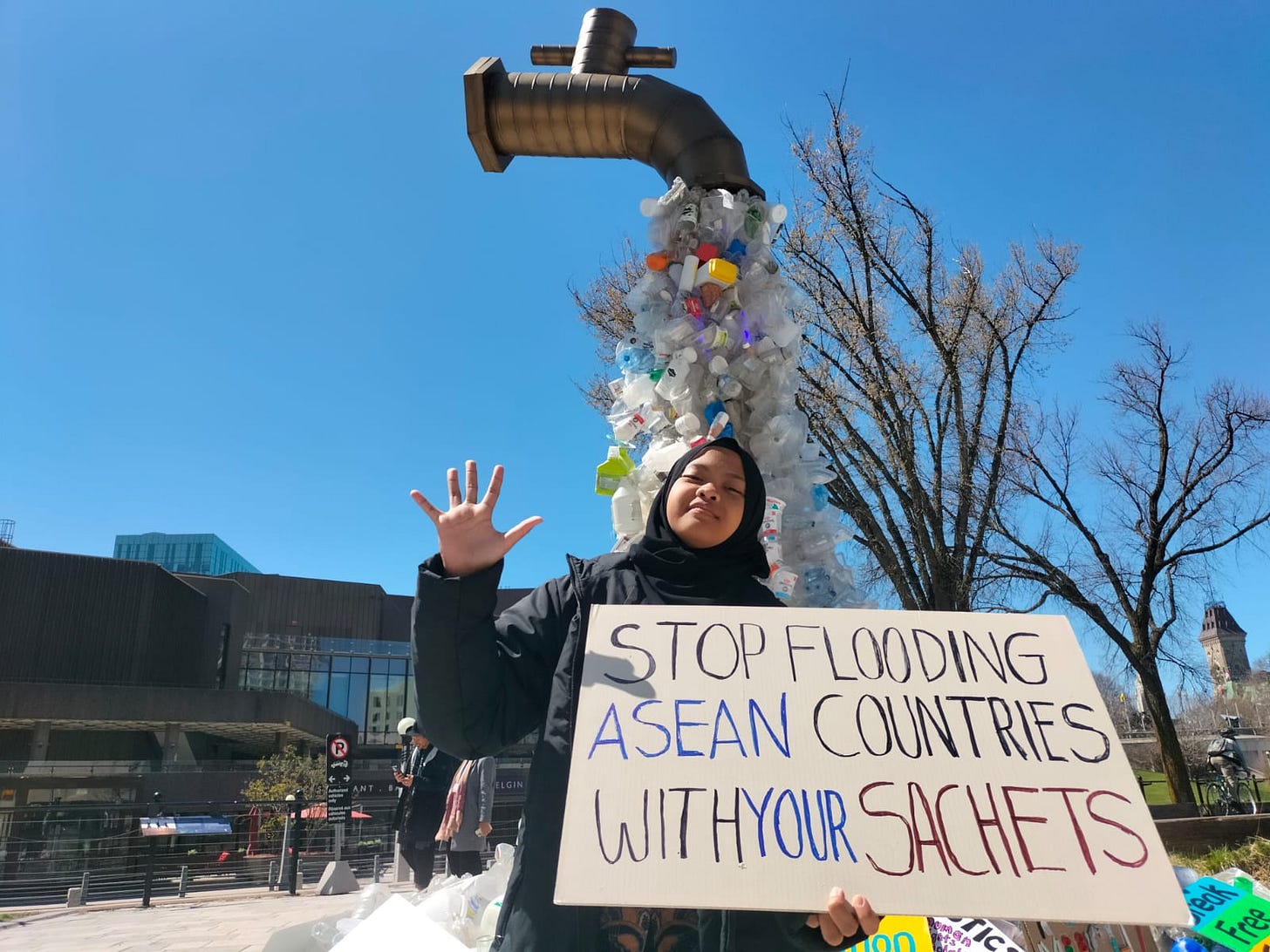🎵 APT, APT: Ambitious Plastic Target 🎶
You sing, you lose. And are probably a karaokeholic Filipino. Prove me wrong with a reply to this newsletter!
Imagine a world where every breath, every sip of water, every bite of food carries invisible plastic particles.
I’m afraid to tell you that this isn't science fiction—it's our current reality. Nearly 1,000 chemicals from food packaging are now circulating in human bodies 🚨
It acts as a silent invasion that demands our immediate attention.
Microplastic pollution in Southeast Asia
The versatile use of plastics comes at a steep cost to our health and environment. Microplastics have been found in rain, air, and even our bodies 🔬
In Southeast Asia, the situation is pretty dire.
Indonesia: Consumes around 15 grams of microplastics per capita per month, the highest globally
Malaysia: at 12 grams per month, ranks second
Vietnam and the Philippines saw 11 grams of MP consumption per person per month
Thailand and Laos: Also make it into the top 10

🏆 While Southeast Asian nations may not top Olympic medal counts, we certainly lead in microplastic consumption.
We're not just witnesses to the plastic crisis—we're key players in its resolution.
But thankfully, we have a unique opportunity to tackle plastic pollution head-on. It’s our chance to rewrite our relationship with plastic.
👉🏻 Check out What is circularity and why you should care

What is the Global Plastic Treaty?
The Global Plastic Treaty is a legally binding agreement created by 175 nations at the United Nations Environmental Assembly (UNEA).
⭐️ Its goal? To end plastic pollution by addressing the entire lifecycle of plastics.
There have been 4 Intergovernmental Negotiating Committee (INC) sessions that took place before with the latest one in Ottawa, Canada in April this year.
An INC is essentially a meeting where representatives from various countries negotiate and draft the text of the international treaty that will be ratified.
What’s at stake? ⏱
The treaty's success hinges on these key points:
A cap on global plastic production with binding national targets
Ban on hazardous chemicals
Effective trade measures
What happened at the previous INCs?
Two main blocs have emerged in the Global Plastic Treaty negotiations:
High Ambition Coalition
Countries: More than 117 countries including the EU, Japan, Australia,
Advocates for a comprehensive approach covering the full plastic lifecycle
✅ YASS to legally binding measures
Aims to reduce plastic production and calls for a global ban
Global Coalition for Plastics Sustainability
Countries: Iran, Saudi Arabia, and other major oil producers, of course 🫤
Favours a narrower focus on waste management
Prefers regional or national strategies over a unified global one
❌ Legally binding measure? How about
NOvoluntary commitments instead?
With this division, the ‘Zero Draft’ from INC4 has an ambiguous nature weaved with brackets due to a lack of a clear consensus.

What’s ASEAN’s stand?
There’s no official list of countries, but as of now, none of the ASEAN countries are part of the High Ambition Coalition, which advocates for a strong Global Plastic Treaty.
🇮🇩🇵🇭 Indonesia and Philippines have actively participated in discussions about reducing plastic waste. These nations are grappling with severe plastic pollution issues, particularly in coastal areas.
🇹🇭 Thailand has also been vocal about its commitment to sustainable practices. The country has implemented national policies aimed at reducing single-use plastics and improving waste management systems, aligning with the treaty's objectives.
🇻🇳 Vietnam is emerging as a leader, setting ambitious targets for reducing plastic waste and actively engaging in international discussions on the issue.
Economic consideration
While many ASEAN nations recognise the need to tackle plastic pollution, they struggle to balance environmental goals with economic realities.
🇸🇬 Singapore has not joined the High Ambition Coalition likely due to its significant energy and chemicals sector. This sector is huge for Singapore’s economy as the world’s ninth-largest exporter of chemicals.
🇲🇾 The Malaysian government has been supportive of the initiatives but faces pressure from its palm oil and petrochemical industries, which are large contributors to the national economy.
It’s hard to adopt stricter regulations without considering their impact on local jobs and exports.
For Southeast Asian nations, this treaty presents an opportunity to reap potential economic benefits from circular economy initiatives.
👉🏻 Check out 3 startups in Southeast Asia that reimagine waste
Our hope for INC5 and the Global Plastic Treaty
The Global Plastic Treaty is hanging by a thread and this is where our attention goes:
Lobbyists shouldn’t hijack the treaty 🚫
There was an overwhelming presence of industry lobbyists in the INC4.
No one needs a plastic-wrapped cucumber. All that does is allow chemicals to leach into our food. Letting profit-driven interests derail our chance is just unacceptable, especially with the health effects we face.
Focus on reducing plastic production and consumption, period 🔄
Downstream measures are like trying to mop up a flood while the tap's still running.
As long as we keep churning out plastics, consumption will rise – no amount of recycling or regulations can fix that.
ASEAN must step up 🫡
It's ridiculous that we're the region most affected by microplastics, yet we're not taking a leading role in these negotiations.
🌱 Individual actions matter, too! Vote for policymakers who prioritise environmental sustainability, make conscious purchasing decisions, and support local initiatives reducing plastic waste.
The world is watching. Our collective action can transform this crisis into an opportunity for meaningful change.
Every choice, every voice, every moment counts in our journey toward a plastic-free future.
Enjoyed this issue? Forward it to a friend and follow us on LinkedIn and X.


